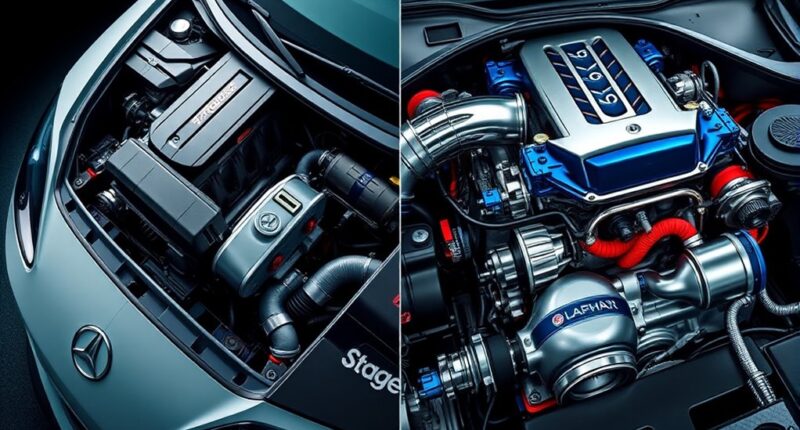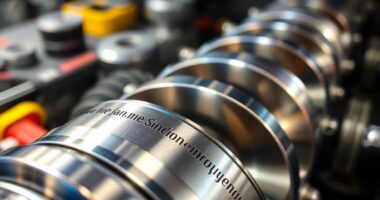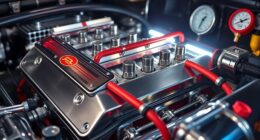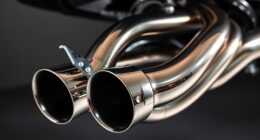Stage 1 tuning involves a simple ECU remap that boosts power and responsiveness without major hardware changes, making it easy to adjust or reverse. In contrast, Stage 2 adds hardware upgrades like intercoolers, exhausts, and turbochargers, delivering markedly higher power but requiring more complex installation. While Stage 1 offers a safer, more flexible upgrade, Stage 2 provides greater performance gains—if you want to explore the full differences, keep going.
Key Takeaways
- Stage 1 involves ECU remapping without hardware changes, while Stage 2 adds physical upgrades like intercoolers and exhaust systems.
- Stage 1 offers moderate power gains with minimal impact on fuel efficiency and engine reliability; Stage 2 provides higher performance but may reduce fuel economy.
- Stage 1 is simple, reversible, and suitable for beginners; Stage 2 is more complex, requiring hardware modifications and technical expertise.
- Stage 2 enables higher boost levels and aggressive fueling, increasing engine stress compared to Stage 1.
- Both stages improve responsiveness, but Stage 2 delivers more significant power increases due to hardware enhancements.

When it comes to optimizing your car’s performance, understanding the differences between Stage 1 and Stage 2 tuning is essential. These tuning stages are popular upgrades that can considerably enhance your vehicle’s power and responsiveness, but they also impact fuel efficiency and engine reliability in different ways. Knowing what each stage involves helps you make a smarter decision based on your driving goals and how much you’re willing to invest.
Stage 1 tuning is designed as an initial upgrade that doesn’t require major modifications to your car’s hardware. It typically involves remapping the engine control unit (ECU) to optimize fuel delivery, ignition timing, and boost pressure within the limits of your factory components. This results in noticeable gains in horsepower and torque without compromising daily drivability. Because it’s more conservative, Stage 1 tuning tends to maintain good fuel efficiency, especially if you drive sensibly, and doesn’t considerably threaten your engine’s reliability. In fact, many enthusiasts see it as a safe entry point into performance upgrades, offering a balance of performance and longevity. It’s a straightforward process that can often be reversed or adjusted easily if needed, making it a popular choice for drivers seeking a bit more power without extensive modifications. Additionally, the impact on engine components is minimal since it stays within factory limits, which helps preserve overall engine reliability.
Stage 2 tuning takes things further by building upon the foundation set by Stage 1. It usually involves additional hardware upgrades such as upgraded intercoolers, exhaust systems, intake manifolds, or turbochargers. These modifications allow for greater airflow and cooling, enabling the ECU to be tuned for even higher boost levels and more aggressive fueling strategies. The result is a notable increase in power and acceleration. However, this comes with increased demands on your engine, which can affect fuel efficiency—often reducing it unless you’re careful with your driving style. More importantly, the added stress on engine components means your engine’s reliability could be at risk if the upgrades aren’t performed properly or if maintenance isn’t kept up. While Stage 2 tuning pushes your car’s performance to higher levels, it requires a more detailed understanding of your vehicle’s limits and often involves more frequent servicing or upgrades to maintain reliability.
Frequently Asked Questions
Can Stage 1 Tuning Void My Vehicle Warranty?
Yes, stage 1 tuning can potentially void your factory warranty, especially if the manufacturer detects the modifications. While some manufacturers are more lenient, many will see aftermarket tuning as a reason to deny coverage under your factory warranty. To avoid issues, check your vehicle’s warranty terms and consult with your dealer before proceeding. Keep in mind that some tuners offer warranty-friendly options, but always verify your manufacturer’s stance first.
Is Stage 2 Tuning Suitable for Daily Driving?
Think of stage 2 tuning like adding a turbo booster to your car—it’s powerful but may feel a bit choppy for daily driving. While performance upgrades can enhance speed and responsiveness, stage 2 tuning often involves more extensive modifications, which might lead to less smoothness and higher fuel consumption. If you prioritize daily reliability, you might find stage 2 tuning less suitable, but if you crave extra power, it’s worth considering.
What Are the Long-Term Effects of Stage 2 Tuning?
Stage 2 tuning can impact your car’s long-term durability and engine reliability. If done properly, it shouldn’t cause major issues, but pushing your engine harder might lead to faster wear on components like pistons, turbos, and the fuel system. Regular maintenance and quality tuning are essential to make certain your engine stays reliable over time. Keep an eye on performance and address any issues early to protect your vehicle’s longevity.
How Much Does Stage 2 Tuning Typically Cost?
Stage 2 tuning typically costs between $800 and $2,500, depending on the vehicle and tuning complexity. You’ll find a higher cost compared to Stage 1, as it involves more extensive modifications and precise calibration. The price varies based on the tuning method and additional hardware needed. Be prepared for a higher investment since the tuning process is more complex and requires specialized skills for peak performance and reliability.
Will Stage 2 Tuning Affect Fuel Efficiency?
Ever wonder if your fuel economy will suffer with stage 2 tuning? It can, since boosting performance gains often means your engine works harder, using more fuel. However, if driven carefully, you might maintain decent efficiency. Keep in mind, the increased power usually comes with a trade-off in fuel economy. So, while you get better performance, be prepared for potential changes in how much gas your vehicle consumes.
Conclusion
Ultimately, understanding the difference between Stage 1 and Stage 2 tuning helps you make an informed decision tailored to your driving needs. While Stage 1 offers a noticeable boost without much fuss, Stage 2 takes it further with more extensive modifications. As the saying goes, “A little knowledge is a dangerous thing,” so always consider your goals and consult professionals before diving into upgrades. Choose wisely, and enjoy the ride to its fullest potential.










